inform, empower, educate…..Aug 2019 Edition
SHADE NET FARMING
What are shade nets?
A shade net is a fabric knitted or woven from HDPE material that is primarily designed to protect crops and animals against harsh radiation from the sun either by absorbing or reflecting light; shade nets however have many other applications which we shall also discuss in this article.
Shade nets are manufactured with different light screening factors and are defined according to the amount or percentage of shade they provide to the crops growing under their cover; this normally ranges from 20% to 90%. Shade nets are also available in multiple colours which helps in shaping the wavelength, intensity and distribution of solar radiation.
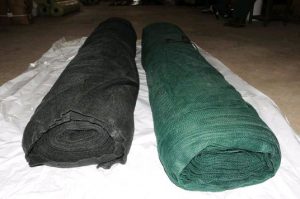 Rolls of black and green shade net
Rolls of black and green shade net
What is the difference between shade net houses and greenhouses?
Shade houses and greenhouses are both used to create micro-environments that try to recreate the natural environments in which the cultivated crops usually grow or to enhance the micro-environment for maximum yields. They both protect crops from natural disturbances like insect pests, birds, hailstorm and strong winds.
The major difference between the two is in the cladding or covering materials which are designed for different purposes and create different micro-climates.
Shade houses create a cool micro climate and are therefore suitable for shade loving crops whereas greenhouses tend to heat up since the UV polythene cover is designed to allow solar radiation to pass through it then traps the resultant thermal energy created inside the greenhouse; this phenomenon is known as ‘the greenhouse effect’. Greenhouses are therefore more suitable for heat loving crops.
Shade houses and greenhouses therefore create two contrasting micro-environments and it is important to understand what you need so as to choose the right structure.
When to use shade nets
Shading screens cut light radiation. Crops that thrive in weak solar radiation environments when grown in areas with (or during seasons of) strong solar radiation are protected from radiation damage using shade nets. Production of such vegetables can generally be enhanced using nets of percentages ranging between 30% to 50%. Vegetables such as lettuce, kales, cabbages, indeterminate tomato varieties, certain herbs and flowers etc can do well under shade net. In certain climatic conditions, heat tolerant crops such as tomatoes and capsicum can also be grown under shade or can benefit from temporary shade cover during periods of high solar radiation.
Dark coloured nets such as black and green are much better at absorbing sunlight keeping the micro climate cool. They are therefore more suitable for crops that thrive under shade such as green leafy vegetables.
The effect of shading is that these crops will have bigger leaves, grow taller and have more nodes and will be able to grow all year round even in environments with scorching sunlight. Lighter colored nets which reflect rather than absorb light are more suitable for flowering plants.
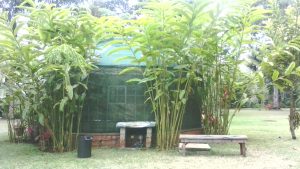 Exterior Exterior |
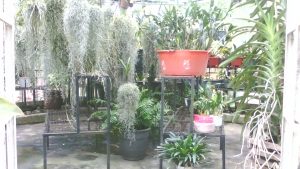
Interior |
A shade house for hobby gardening of flowers
Role of shade nets in Agricultural Farming.
Application of shade nets in Agriculture include:
- Protecting plants from radiation damage by reflecting or absorbing harmful UV radiation.
- Reduction of water uptake/irrigation water use because of the resultant low day time temperatures created.
- Protection of crops from pests such as caterpillars, locusts, white flies etc. Insect pests not only damage the crops directly but also spread diseases.
- Reducing strong winds, hail damage and bird damage.
- Preventing overheating in greenhouses. Greenhouses can be covered with shade nets to reduce build up of heat.
- For seedling propagation.
- As water dam and fish pond covers to prevent entry of contaminants and predators and also to reduce evaporation.
- Reduction of effects of windblown chemicals on crops.
- As privacy barriers and fences.
Cost
Shade net farming just like greenhouse farming requires some initial capital for infrastructure set up. We have shade nets available in the following percentages and colours (Other densities are manufactured on order):
| Density | Colour | Cost in KES per Square meter |
| 50% | Black and Green | 75 |
| 75% | Black and Green | 90 |
| 90% | Black | 110 |
The net is only one part of a shade net structure. A complete structure will consist of the framework which could be either steel or wooden, fastening materials like profiles and zigzag wire, clamps, bolts and tapping screws.
Steel has obvious advantages of strength, durability, portability and aesthetic appeal over wood; this makes steel frameworks the preferred choice for shade house construction. Please send quotation request for complete structures using the contacts provided.
 Steel framework ready for covering. Steel framework ready for covering. |
|
Point to remember
Shade nets play a very important role in agriculture. They can be mounted on wooden or steel frame works and are available in different colors and percentages ranging from 20% to 90%. They can protect your animals and crops from natural disturbances like excess sunlight radiation, strong winds, hailstorm, heavy rain, birds and insects.
With the use of shade nets, you reduce your water usage as a result of reduced day temperatures; you also reduce crop wastage resulting from sun scorch. Ultimately shade nets increase productivity which in turn leads to higher profits for farmers.
Apart from agricultural use, shade nets are also used in the construction industry to cover construction sites and on car parks.
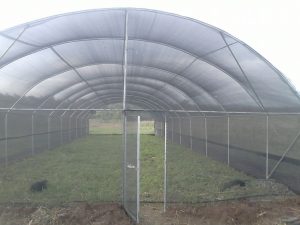 Shade net structure – Dome shaped Shade net structure – Dome shaped |
|
If you are looking for high quality shade cloth for your crops please contact us on 0721-681943 or email info@aceagriculture.co.ke or email the writer directly on copala@aceagriculture.co.ke
*************************************************************************************
The writer, Clifton Opala is the founder of Ace Intergrated Services, an Agricultural Services Firm offering end to end solutions to farmers. The firm specializes in Construction of Greenhouses, Shade structures & other Farm Structures; Irrigation Systems Design and Installation; Farm planning, establishment & Management; Ground water identification & Drilling and Farmer Training & Extension Services. The firm also has capacity to design and conduct Baseline and Impact Assessment Surveys for Agricultural Interventions.
P.O. Box 26619-00100 Nairobi
Tel: +254-721-681943
Email: copala@aceagriculture.co.ke
Facebook: @aceagriculturekenya
Website: www.aceagriculture.co.ke

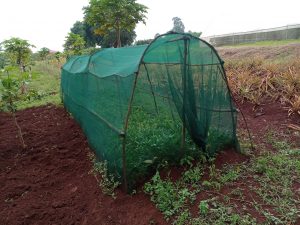 Simplified wooden framework used for shade covering for sweet potato vine propagation.
Simplified wooden framework used for shade covering for sweet potato vine propagation.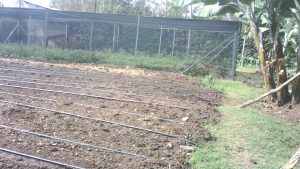 Shade net structure – Flat roof
Shade net structure – Flat roof
Comments: (6)
Kisinga
August 19, 2019 |
Good stuff !!
How durable are the shade nets? and what solution for shade nets do you offer to farmer with a land with fruit trees too?
admin
September 26, 2019 |
Thank you. The nets are UV treated meaning they can withstand harsh UV rays without degrading. Unless they are physically damaged you can expect them to serve you for a minimum of 5 years. However even after the UV effect wears off, they will still provide shading. Fruit tree farmers largely use shade nets for tree seedling propagation purposes and as sorting and packaging sheds. Your workers can also find a cool place to relax under shade net during their breaks.
Orora
August 19, 2019 |
Good piece. In an area like Nairobi on a cost benefit scale, would you advice on one having shade net or a green house?
admin
September 26, 2019 |
Thank you. Nairobi presents a good market for high value crops like Tomatoes, Coloured Capsicum and Cucumber. These would do much better in a greenhouse so I would prioritize greenhouse investment over shade net in Nairobi.
eunony@yahoo.se
August 19, 2019 |
I need quotations please
admin
September 26, 2019 |
Thank you. Please provide additional details using the email info@aceagriculture.co.ke and we will be happy to serve you.
leave a comment
Leave a Reply to admin Cancel reply